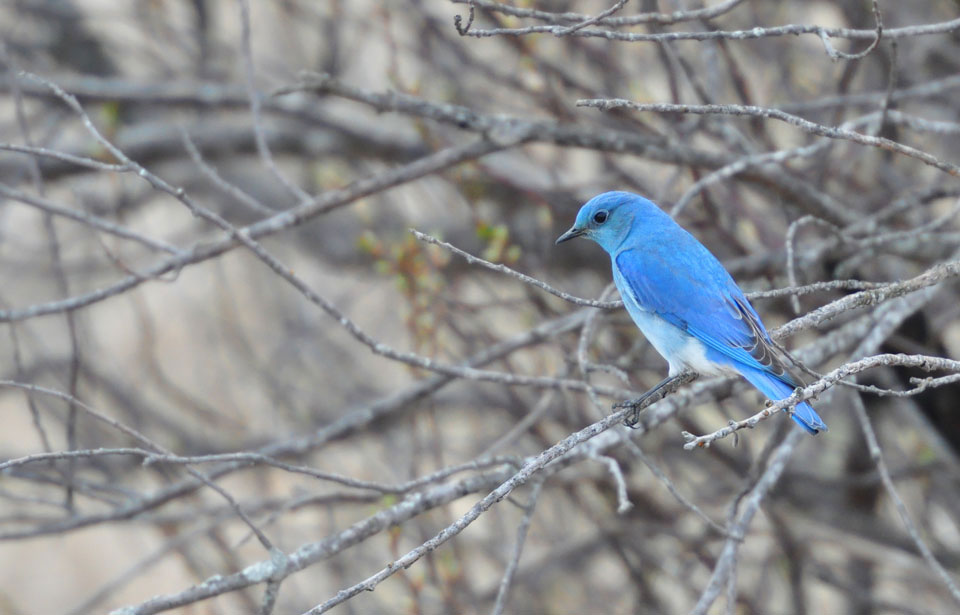A tiny forest songbird called the prothonotary warbler is in deep trouble in southern Ontario. As few as four to 13 pairs of these bright yellow birds remain in Canada. Like many other woodland birds, they are gradually disappearing as we carve up forests for logging, farming, roads, and human habitations. This “fragmentation” decreases the distance between a forest’s edge and its interior, making songbird nests more vulnerable to predators like cats, skunks, crows, and raccoons. At the same time, cavity-nesting birds (like the prothonotary warbler) are having a harder time finding shelter because of the decreasing availability of hollow trees.
But there is reason for hope. The eastern bluebird, too, was once a rarity. Its numbers plunged due to habitat loss and the invasion of the European starling, which usurps tree cavities and deprives native birds of nesting sites. Thanks to people putting up artificial nesting boxes throughout its range, the eastern bluebird has made an extraordinary comeback. The Committee on the Status of Endangered Wildlife in Canada recently removed the eastern bluebird from its list of species at risk.
We can help solve the songbird housing crisis — while practicing a truly higher form of sustainability — by keeping our human junk out of landfills and turning it into songbird shelters. What’s garbage to us can be home to birds!
Turn scrap wood into birdhouses: Mount nesting boxes on posts or under eaves to shelter songbirds and boost their populations. This simple structure will accommodate bluebirds, prothonotary warblers, tree swallows, nuthatches, titmice, chickadees, and wrens, as well as deer mice and flying squirrels. Invasive starlings and house sparrows can be excluded by making the entrance hole no bigger than specified in the following instructions.
- Reduce waste and material costs by using scrap wood, which most lumber yards will sell at a tremendous discount or donate. Waste-exchange services in many Canadian municipalities also supply reusable lumber at nominal prices or free of charge.
- Start with a single plank of scrap pine or cedar, 3/4” x 5 1/2” x 4’ (lumber is sold in imperial measures).
- Cut the plank into six panels: 11” (back), 8” (front), 8” (roof), 8” (side), 8” (side), and 4” (floor).
- Assemble panels using 2” coated flat-head screws. To keep the wood from splitting, pre-drill screw holes with a bit slightly smaller than the diameter of the screw.
- Drill a 1 1/8” diameter entrance hole 1” from the top of the front panel (1 1/2” diameter for bluebirds and tree swallows, 1 1/4” for nuthatches and flying squirrels).
- Drill four 1/4” diameter drainage holes in the bottom panel and two 1/4” ventilation holes near the top of each side panel.
- Mount the box 6 to 10’ from the ground, no later than mid-April.
- Unscrew one side panel and clean out nesting materials each fall.
Transform waste into brush piles: Recycle woody debris, such as fallen branches and clippings from pruned shrubs and trees, to create shelter for songbirds. Brush piles not only provide year-round cover for birds, they also are excellent nesting sites for small mammals and invertebrates.
- To build a brush pile with optimum value for birds, select eight or so straight, untrimmed branches about 2m long.
- Arrange the branches in a teepee-like framework, with butt-ends anchored in the ground and tips interlocking. The idea is to create an internal space where occupants can perch safely off the ground.
- Pile evergreen boughs on the top and sides of this framework to form a dome.
- For added benefit, train climbing vines, such as Virginia creeper, scarlet runner bean, or honeysuckle, onto the brush pile during planting season.
- Each year, add a few new boughs. Leftover corn stalks will make a welcome addition to the brush pile in the fall.



